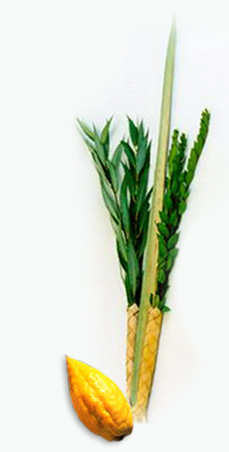|
 |
It is written in the Book of Vayikra, 23:40, |
“You shall take for
yourselves on the first day -
the fruit of a citron
tree, the branches of date palms, twigs of a platted tree, and brook willows” |
| The Rabbis explain that
this verse refers to the Lulav, Etrog, Hadas and Aravah. |
| Therefore, on the festival of Sukkot we ‘take’ - |
- the Lulav (a branch from
the centre of a date palm),
- the Etrog ( a specific
citrus fruit),
- 3 branches from the Mertyl
tree and
- 2 Willow branches, to
fulfil the Mitzvah (commandment) of Lulav and Etrog.
|
Although the commandment
from the Torah is only for ‘the first day’,
the Rabbis instituted the custom of taking the Arba’at Hamininm (four
species)
on all 7 days of Sukkot. |
| |
| |
| |
| |
| It is also said that the
four species represent 4 different types of Jews. |
| The Etrog, which has a beautiful scent and taste, represents someone who learns
Torah and does Midot Tovot (good deeds). |
| The Lulav, which has no scent but a nice taste, represents a person who learns
Torah, but lacks good deeds. |
| The Hadas, which has a beautiful scent, but no taste, represents a person
who does good deeds but lacks Torah. |
Finally, the Aravah, which has no taste or scent, represents a person who
neither learns Torah or does good deeds. |
| These four types of people all exist within the Jewish nation. By bringing
the four species together, it is a symbol of bringing all types of Jews together. |
| According to Jewish tradition, regardless if a Jew is a great Tzaddik (righteous person) and Talmid
Chacham (learned person), or a simple, ordinary person, it is important
that the Jewish nation has Achdut (unity), and come together as one.
Only then, tradition says, will the final redemption of the Jewish people transpire. |
|
| |
| |
| |
| |
| |
| |
| |
| |
Thanks to Rafi Karp of Bnei Akiva Melbourne |
| |
